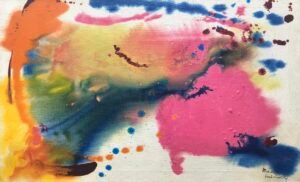Marcelle LOUBCHANSKY (1917–1988) was a Franco-Russian painter renowned for her contributions to Lyrical Abstraction, a movement that emerged in post-World War II Paris. Her work is characterized by fluid, gestural compositions and cosmic-inspired paintings, evoking a sense of depth, movement, and ethereal expansiveness. Loubchansky’s innovative use of diluted pigments introduced a vaporous quality to her compositions, enabling her to explore themes of form and motion in a distinctive and evocative manner.
She held her first exhibition in 1948 at Galerie Breteau and later became associated with Tachisme, exhibiting at L’Étoile Scellée under the artistic direction of André Breton. Alongside contemporaries such as Simon Hantaï and Judith Reigl, she explored the expressive potential of form, movement, and gesture in her work. Praised by Surrealist leaders for her ability to evoke elemental forces through abstraction, she gained further recognition when Jean Fournier began exhibiting her work at Galerie Kléber in 1954 alongside Sam Francis and Joan Mitchell. She remained part of this group until 1965 and was featured on the cover of Harper’s Bazaar in an article highlighting Galerie Kléber’s artists.
Within a few years, Loubchansky gained widespread recognition, and her painting evolved significantly. Her experiments with diluted color were groundbreaking, bringing an unprecedented fluidity to her treatment of form. Initially highly controlled, her surfaces gradually opened up, creating vast spaces that simulated a cosmic universe, with color absorbed into the fabric of the canvas. By the late 1960s and throughout the 1970s, Loubchansky shifted her focus toward what she called Prospectives Stellaires (Stellar Perspectives). The cosmos and its endless variations became her primary themes, marking a new visionary phase in her artistic exploration.
In recent years, there has been renewed interest in Loubchansky’s work, leading to its inclusion in various exhibitions. Notably, her pieces were featured in group exhibitions at Galerie Hervé Courtaigne in Paris and Musée de Tessé in Le Mans. Loubchansky’s legacy in contemporary art is marked by her pioneering approach to abstraction and her ability to convey profound emotion through color and form. Her works continue to inspire artists and captivate audiences, underscoring her significant role in the evolution of modern art.


